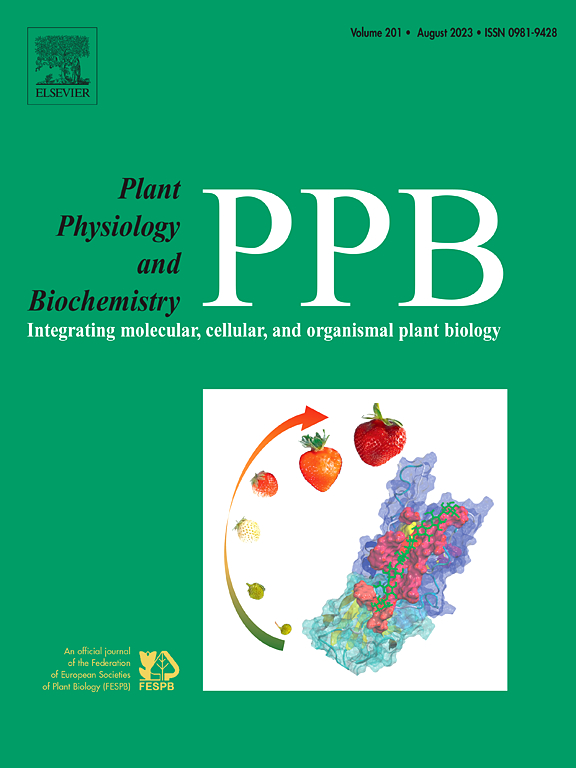The teamwork of melatonin, ethylene and H2S in abiotic stress adaptation in plants
IF 6.1
2区 生物学
Q1 PLANT SCIENCES
引用次数: 0
Abstract
Abiotic stresses significantly reduce plant growth and productivity, challenging agricultural sustainability. Plants have evolved adaptive mechanisms to counter these stresses, including antioxidant defences, biochemical changes, and hormonal signaling. Among these, the hormone melatonin (MT) and signaling molecules, ethylene (ET) and hydrogen sulfide (H2S), play pivotal roles, interacting in complex ways that modulate stress responses. Melatonin, known for its antioxidant properties, interacts with ET pathways to regulate its production. While ET is essential for stress signaling, its overproduction can exacerbate oxidative damage, and MT helps modulate ET levels to prevent such detrimental effects. Moreover, MT regulates H2S synthesis by activating L-cysteine desulfhydrase (LCD) and D-cysteine desulfhydrase (DCD), enhancing its protective effects under stress. Hydrogen sulfide supports MT synthesis, indicating a bidirectional relationship. Evidence suggests that H2S plays a role in fine-tuning ET levels under stress conditions, supporting optimal signaling for resilience. This review explores the intricate interactions among MT, ET, and H2S, shedding light on potential crosstalk mechanisms that strengthen plant stress tolerance, aiming to enhance crop resilience through targeted manipulation of these pathways.
褪黑素、乙烯和H2S在植物非生物胁迫适应中的协同作用
非生物胁迫大大降低了植物的生长和生产力,对农业的可持续性提出了挑战。植物已进化出应对这些胁迫的适应机制,包括抗氧化防御、生化变化和激素信号转导。其中,激素褪黑激素(MT)和信号分子乙烯(ET)和硫化氢(H2S)发挥着关键作用,它们以复杂的方式相互作用,调节胁迫反应。褪黑激素以其抗氧化特性而闻名,它与乙烯通路相互作用,调节乙烯的产生。虽然 ET 对应激信号转导至关重要,但它的过度产生会加剧氧化损伤,而 MT 有助于调节 ET 水平,从而防止这种有害影响。此外,MT 还能通过激活 L-半胱氨酸脱硫水解酶(LCD)和 D-半胱氨酸脱硫水解酶(DCD)来调节 H2S 的合成,从而增强其在应激状态下的保护作用。硫化氢支持 MT 的合成,表明这是一种双向关系。有证据表明,在应激条件下,硫化氢在微调 ET 水平方面发挥着作用,从而支持恢复能力的最佳信号传递。本综述探讨了 MT、ET 和 H2S 之间错综复杂的相互作用,揭示了加强植物抗逆性的潜在串联机制,旨在通过有针对性地操纵这些途径提高作物的抗逆性。
本文章由计算机程序翻译,如有差异,请以英文原文为准。
求助全文
约1分钟内获得全文
求助全文
来源期刊
CiteScore
11.10
自引率
3.10%
发文量
410
审稿时长
33 days
期刊介绍:
Plant Physiology and Biochemistry publishes original theoretical, experimental and technical contributions in the various fields of plant physiology (biochemistry, physiology, structure, genetics, plant-microbe interactions, etc.) at diverse levels of integration (molecular, subcellular, cellular, organ, whole plant, environmental). Opinions expressed in the journal are the sole responsibility of the authors and publication does not imply the editors'' agreement.
Manuscripts describing molecular-genetic and/or gene expression data that are not integrated with biochemical analysis and/or actual measurements of plant physiological processes are not suitable for PPB. Also "Omics" studies (transcriptomics, proteomics, metabolomics, etc.) reporting descriptive analysis without an element of functional validation assays, will not be considered. Similarly, applied agronomic or phytochemical studies that generate no new, fundamental insights in plant physiological and/or biochemical processes are not suitable for publication in PPB.
Plant Physiology and Biochemistry publishes several types of articles: Reviews, Papers and Short Papers. Articles for Reviews are either invited by the editor or proposed by the authors for the editor''s prior agreement. Reviews should not exceed 40 typewritten pages and Short Papers no more than approximately 8 typewritten pages. The fundamental character of Plant Physiology and Biochemistry remains that of a journal for original results.

 求助内容:
求助内容: 应助结果提醒方式:
应助结果提醒方式:


